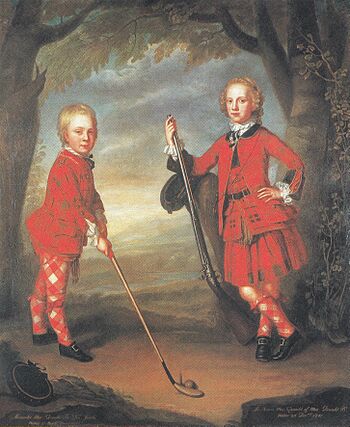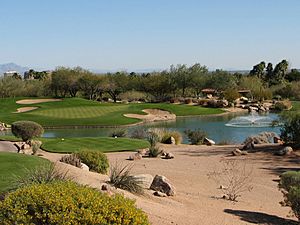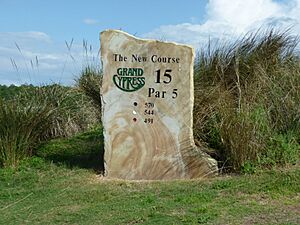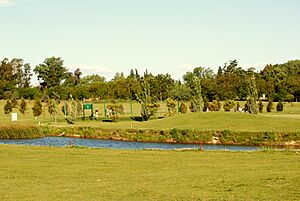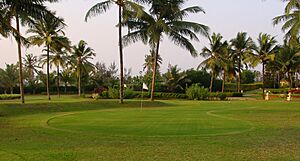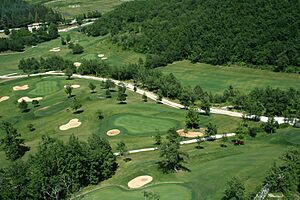Golf facts for kids

A golfer in the finishing position after hitting a tee shot
|
|
| Highest governing body | The R&A USGA IGF |
|---|---|
| First played | 15th century, Kingdom of Scotland |
| Characteristics | |
| Contact | No |
| Type | Outdoor |
| Equipment | Ball, clubs, tee |
| Glossary | Glossary of golf |
| Presence | |
| Olympic | 1900, 1904, since 2016, |
Golf is a fun club-and-ball sport where players use different clubs to hit a ball. The goal is to get the ball into a series of holes on a course. You want to do this using as few hits (called "strokes") as possible!
Unlike many other ball games, golf doesn't have a standard playing field. Each golf course is unique. This means players need to be good at handling different types of land. A course usually has 9 or 18 "holes." Each hole has a special area called a teeing ground where you take your first shot. It also has a putting green with a small cup where the ball goes. Between the tee and the green, you'll find areas like the fairway (short grass), rough (taller grass), and "hazards". Hazards can be water, rocks, or sand traps called bunkers.
Golf can be played in two main ways. In stroke play, you count all your hits for the whole game, and the person with the lowest total wins. This is the most common way golf is played, especially by professionals. In match play, players compete hole by hole. The person who wins the most holes wins the game.
The modern game of golf started in Scotland in the 1400s. The idea of playing 18 holes in a round began at the Old Course in St Andrews in 1764. The world's oldest golf tournament, The Open Championship, started in 1860 in Scotland. It's one of the four biggest tournaments for men's professional golf. The others are The Masters, the U.S. Open, and the PGA Championship, all played in the United States.
Contents
How Golf Began and Grew

While modern golf started in Scotland in the 1400s, its very old beginnings are not clear. People have different ideas about where it truly came from.
Some historians think golf might have come from an old Roman game called paganica. In this game, people used a bent stick to hit a leather ball filled with feathers. One idea is that this game spread across Europe with the Romans and slowly changed into golf.
Others believe it came from chuiwan (pronounced "chway-wahn"), a Chinese game played between the 700s and 1300s. A painting from 1368 shows a Chinese court member hitting a small ball with a club towards a hole. Some think this game was brought to Europe a long time ago.
Other old games that looked like golf include cambuca in England and chambot in France. There was also a game called kolven played in the Netherlands in the late 1200s.
The game we know today really took off in Scotland. The first written record of golf is from 1457. King James II banned the game because he thought it was distracting people from practicing archery. Later, King James IV lifted the ban in 1502 because he started playing golf himself!
The Old Course in St Andrews is a very famous golf spot. It's been around since before 1574. In 1764, the 18-hole golf course standard was set there. This happened when the course was changed from 22 holes to 18. The oldest golf course in the world, Musselburgh Links, has records of golf being played there as early as 1672.
The first official rules of golf were written in 1744 in Scotland. The world's oldest golf tournament, The Open Championship, was first played in 1860. Scottish golfers won the first few of these big events. Golf was first shown in the U.S. in 1888 by two Scotsmen, John Reid and Robert Lockhart. Reid then started America's first golf club in New York.
The Golf Course Layout

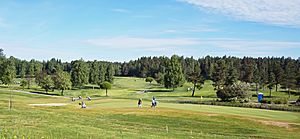
A golf course has either 9 or 18 holes. Each hole has a teeing ground (or "tee box") where you start. This area is marked by two markers. Then there's the fairway (short grass), rough (taller grass), and other hazards. Finally, there's the putting green with a flagstick (called a "pin") and the cup.
The grass is cut at different heights to make the game harder or easier. For example, the green has very short grass for putting. Many holes are straight, so you can see the green from the tee. But some holes curve to the left or right. This is called a "dogleg," like a dog's bent knee. If it curves left, it's a "dogleg left." If it curves right, it's a "dogleg right." Sometimes, a hole might curve twice, which is a "double dogleg."
Most golf courses have 18 holes. However, 9-hole courses are also common. You can play a 9-hole course twice to complete a full 18-hole round.
Early Scottish golf courses were often built on "links land." This is sandy land near the coast, often with sand dunes. This is why some courses, especially by the sea, are called "golf links."
The first 18-hole golf course in the United States was built on a sheep farm in Illinois in 1892. It's still there today!
How to Play the Game
A game of golf means playing a certain number of holes in order. A "round" usually means playing all 18 holes on a course. You play each hole once. Golf can be played by any number of people, but a typical group has 1 to 4 players. A 9-hole round usually takes about two hours, and an 18-hole round takes about four hours.
To start a hole, you hit the ball from the teeing ground. For this first shot, you can place the ball on a tee. A tee is a small peg that lifts the ball slightly off the ground. Tees are usually made of wood or plastic. Long ago, golfers used small piles of sand instead of pegs. Lifting the ball makes it easier to hit cleanly.
When you want to hit the ball a long way, usually more than 200 meters (225 yards), this shot is called a "drive." You usually use a long club called a "driver" for this. For shorter holes, you might use other clubs. After your first shot, you keep hitting the ball until it reaches the green. These shots can be called a "lay-up," "approach," "pitch," or "chip." Once the ball is on the green, you "putt" it into the hole.
Getting the ball into the hole in as few strokes as possible can be tricky. Obstacles like "rough" (long grass), "doglegs" (curving fairways), bunkers (sand traps), and water hazards (ponds or streams) can make it harder.
In stroke play, you must hit the ball until it's in the hole, no matter how many tries it takes. In match play, if you know you can't win the hole, you can just pick up your ball and give up that hole. This speeds up the game.
Playing a full round of golf means walking a long distance. The total distance from the first tee to the 18th green can be over 6,400 meters (7,000 yards). With walking between holes, players might travel 8 kilometers (5 miles) or more! Some courses let you use golf carts to get around, which makes the game faster and easier for those who can't walk as much. On other courses, players walk, carrying their own bags or using a "golf trolley." Professional golfers often have caddies who carry their equipment and offer advice.
Rules and Fair Play

The rules of golf are the same all over the world. They are managed by two main groups: The R&A (from Scotland) and the United States Golf Association (USGA). In 2019, they made the rules simpler.
The main idea behind the rules is fairness. As the rule book says: Play the ball as it lies, play the course as you find it, and if you cannot do either, do what is fair.
There are also rules about being an amateur golfer. If you get paid to teach golf or play for money, you are not an amateur. You can't play in amateur-only competitions. However, amateur golfers can get money for travel and accept small prizes.
Besides the official rules, golfers also follow "golf etiquette." These are guidelines for being safe, fair, playing at a good speed, and taking care of the course. Even though there are no penalties for breaking etiquette rules, most players follow them to make the game better for everyone.
What Happens if You Break a Rule?
If you break a rule, you might get "penalty strokes." These are extra strokes added to your score, as if you hit the ball more times. Most rule breaks add one or two strokes. Very serious or repeated rule breaks can lead to disqualification (being removed from the game). Here are some examples:
- If you lose your ball or hit it out of bounds, you get a one-stroke penalty and have to hit again from where you last played.
- If you accidentally move your ball, it's usually a one-stroke penalty.
- If your ball lands in a water hazard or an unplayable spot, you can take a one-stroke penalty to move it.
- Hitting the wrong ball (not yours) is a two-stroke penalty.
- Hitting another player's ball on the green is a two-stroke penalty.
- Cheating or signing for a lower score than you actually got can lead to disqualification.
Golf Equipment
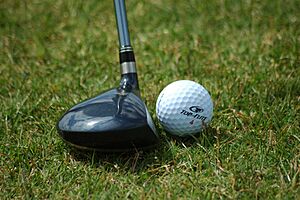
You use golf clubs to hit the golf ball. Each club has a long stick (called a "shaft"), a handle (called a "grip"), and a club head at the bottom. Clubs that hit the ball far have a lower angle (less "loft"). Clubs that hit the ball shorter distances have a higher angle (more "loft"). The club's length also depends on how far it's meant to hit the ball.
Golf clubs come in three main types:
- Woods: These clubs have large heads and long shafts. They are used to hit the ball very far, usually from the teeing ground or fairway. The "driver" (or "1-wood") is the most powerful wood. It's designed for super long shots, sometimes over 270 meters (300 yards) for pros! Woods used to be made of wood, but now they are mostly metal or other strong materials.
- Irons: These clubs have shorter shafts and metal heads with a flat, angled face. Irons are used for many different shots, especially for shorter distances when you're getting closer to the green. They are also good for hitting the ball out of tricky spots like sand traps.
- Putters: These clubs are specially designed to roll the ball along the green and into the hole. You almost always use a putter when your ball is on the green.
There's also a newer type of club called hybrids. These are a mix between woods and irons. They are often used instead of long irons because they are easier to hit and send the ball higher.
You can only have a maximum of 14 clubs in your bag during a game. You choose which clubs to use, but they must all follow certain rules. If your clubs don't follow the rules, you could be disqualified.
The golfer always decides which club to use for any shot. There are no rules telling you which club you must use at a certain time.
Golf balls are round, usually white, and have small dimples. These dimples help the ball fly farther by making the air flow around it better.
A tee can only be used for your first shot on each hole.
Many golfers wear golf shoes with spikes. These spikes help you grip the ground better, which can lead to more powerful and accurate shots.
A golf bag is used to carry your clubs and other gear like tees, balls, and gloves. You can carry your golf bag, pull it on a trolley, or put it on a motorized golf cart.
How to Swing the Club
A golf swing looks a bit like swinging an axe or a baseball bat. But in golf, many small movements must happen perfectly together. This makes sure the club hits the ball in the right way, with the clubface facing the right direction, and that the ball hits the "sweet spot" (the best part) of the clubface. Being able to do this consistently with all your different clubs is a very important skill in golf. It takes a lot of practice!
Getting Ready: Your Stance
"Stance" means how you stand to hit the ball. It's super important for hitting the ball well. You'll always crouch a little bit. This helps you hit the ball with more power and control. If you're right-handed, your left side will face the target. When you set up with your club behind the ball, this is called being "at address." Your body and the clubface should be lined up with where you want the ball to go.
Your feet are usually about shoulder-width apart for middle irons and putters. They might be closer together for short irons and wider for long irons and woods. For clubs that hit the ball far, the ball is usually closer to your front foot. For putts and iron shots, the ball is usually in the middle of your stance.
Different Types of Shots
Golfers choose a club and a type of swing based on how far they want the ball to go:
- The "Drive" or "Full Swing": Used on the teeing ground and fairway with woods or long irons. This swing aims for the longest possible distance. Your backswing (when you bring the club back) can go very far, sometimes with the club shaft parallel to the ground above your shoulders.
- The "Approach" or "3/4 Swing": Used for medium to long distances when you need good accuracy more than maximum distance. For example, to land the ball on the green. The backswing is shorter, with the club pointing mostly upwards.
- The "Chip" or "Half-Swing": Used for short shots near the green with high-lofted irons. The goal is to land the ball on the green and let it roll towards the hole. The backswing is shorter, with the club head between your hip and head height.
- The "Putt": Used for very short shots on or near the green, usually with a putter. The swing is very small, with the club head rarely going above your knee. The goal is usually to get the ball into the hole. A long putt might just aim to get the ball close to the hole.
After choosing your club and swing, you stand next to the ball and place your club behind it (unless it's in a hazard). Then you take your backswing, turning your body and arms away from the ball. Finally, you swing the club down and around to hit the ball. A good golf swing is complicated! Small changes in how you stand or move can make a big difference in how well you hit the ball and how straight it goes. The main goal is to swing the club head as fast as you can, keeping it on a smooth path, so it hits the ball exactly where you want it to go.
Being accurate and consistent is often more important than hitting the ball super far. A player who hits the ball straight, even if it's only 200 meters (220 yards), can place the ball in a good spot on the fairway. They can make up for less distance by using a "lower loft" club (one that hits the ball farther) for their next shot. But a golfer who hits the ball 250 meters (280 yards) but often hits it crooked might end up in the rough or hazards, needing more strokes to finish the hole.
Muscles Used in Golf
A golf swing uses many muscles in your body. Your core muscles (like your back and side muscles) are important for turning. Your leg muscles (like your hamstrings), shoulders, and wrists are also key. Strong wrist muscles help prevent injuries during swings. Golf is a one-sided exercise, so it's good to do other exercises to keep your body balanced.
Different Ways to Putt
Putting is often seen as the most important part of golf. Over time, many different putting styles and ways to hold the club (grips) have been invented.
- Conventional Grip: This is the traditional way, with your dominant hand lower on the grip and your weaker hand on top. There are variations like "overlap" (fingers overlap) and "interlock" (fingers interlock).
- Cross-Handed Putting: This has become popular. Your dominant hand is on top, and your weaker hand is on the bottom. This helps keep your dominant hand from moving too much, making your putting stroke more steady.
- The Claw: In this style, your dominant hand holds the grip between your thumb and index finger, with your palm facing the target. Your weaker hand holds the putter normally.
- Anchored Putting: This style used a longer putter that could be rested against your stomach or chin to make the stroke more stable. However, this style has been banned in professional golf since 2016.
Scoring and Handicaps
Understanding "Par"
Each hole on a golf course has a "par" score. This is the number of strokes a very good golfer is expected to take to finish that hole. Par is figured out by how far it is from the tee to the green, plus two putts. So, the fewest strokes for any hole is 3 (one hit to the green, two putts). Most courses have par-3, par-4, and par-5 holes. Very rarely, you might see a par-6 or even par-7 hole.
For men, a par-3 hole is usually less than 230 meters (250 yards). A par-4 hole is between 230 and 410 meters (251-450 yards). A par-5 hole is longer than 410 meters (450 yards). These distances are a bit shorter for women and longer for professional golfers. Even though length is the main thing, other things like hills or hazards can also affect a hole's par.
If a golfer gets the ball onto the green in two strokes less than par, it's called making "green in regulation" (GIR). Getting a GIR doesn't guarantee a par, because you might still need more than two putts. But it makes it easier! Professional golfers usually hit the green in regulation 60% to 70% of the time.
Most 18-hole courses have a total par score of 70 to 72 for the whole round. This means most holes are par 4, with a few par 3s and par 5s. Courses also have difficulty ratings, which help figure out a golfer's handicap.
Golf Scores Explained

The goal in golf is to have the lowest score possible. Your score for a hole, a round, or a tournament is compared to the par score. You might hear someone say they are "under-par" or "over-par."
A hole in one (or "ace") is when you hit the ball directly into the cup from the tee with your first shot! This is very exciting. Here are names for common scores on a hole:
| Number of strokes under/over par | Name | Meaning |
|---|---|---|
| −4 | Condor | four strokes under par |
| −3 | Albatross (Double eagle) | three strokes under par |
| −2 | Eagle | two strokes under par |
| −1 | Birdie | one stroke under par |
| E | Par | equal to par |
| +1 | Bogey | one stroke over par |
| +2 | Double bogey | two strokes over par |
| +3 | Triple bogey | three strokes over par |
In professional golf, players often get "birdies" (one under par) and "bogeys" (one over par). Eagles (two under par) are less common but still happen. A "condor" (four under par) is extremely rare and has almost never happened in a professional tournament.
Main Ways to Play Golf
There are two main ways to play golf: match play and stroke play. Stroke play is more popular.
Match Play
In match play, two players (or two teams) play each hole as a separate contest. The person or team with the lower score wins that hole. If scores are tied, the hole is "halved" (tied). The game is won by the person or team who wins more holes overall. If one player gets so far ahead that the other player can't catch up, the game ends early. For example, if someone is up by six holes with only five holes left, they win "6 & 5."
Stroke Play
In stroke play, you add up the score for every single hole you play. The player with the lowest total score wins. This is how most professional golf tournaments are played. If there's a tie at the end of a professional tournament, players go into a "playoff." This might be a "sudden death" playoff where the first person to win a hole wins the tournament, or they might play a few more holes.
Other Ways to Play Golf
There are many other fun ways to play golf, some of which are official rules. These include different scoring systems and team games.
Sometimes, in big tournaments, players don't all start on the first hole. A "two-tee start" means half the players start on the first hole and the other half start on the tenth hole. A "shotgun start" is common for amateur tournaments. In this, each group of players starts on a different hole at the same time. This way, everyone finishes their game around the same time.
Bogey or Par Competition
In this game, you compare your score on each hole to the hole's par. If you get a birdie or better, you "win" the hole. If you get a bogey or worse, you "lose" the hole. If you get par, you "halve" (tie) the hole. This makes it easy to keep score, and a really bad hole won't ruin your whole game. The player with the most "wins" compared to "losses" wins the competition.
Stableford Scoring
The Stableford system is a simpler way to score than stroke play. You get points based on your score compared to par. For example, a double bogey or worse is zero points, a bogey is one point, par is two, a birdie is three, and an eagle is four. The person with the most points wins. This system has a few benefits:
- A higher score is better, which feels more natural.
- You can compare scores from different courses easily.
- A really bad hole won't ruin your whole game, because you just get zero points for it.
- You can pick up your ball if you can't score any points, which speeds up play.
There's also a "Modified Stableford" system for very good players. This system gives more points for birdies and eagles, and takes away points for bogeys. It encourages players to take more risks to get better scores.
Team Games for Pairs
- Foursomes (Alternate Shot): Two players form a team and share one ball. They take turns hitting the ball. For example, Player A hits the first shot, Player B hits the second, and so on. They keep alternating until the ball is in the hole. For the next hole, the other player starts.
- Greensomes (Scotch Foursomes): Both players on a team hit their first shot (tee off). Then they choose the best of the two shots. The player whose shot was NOT chosen hits the second shot. After that, they alternate shots like in Foursomes.
- Four-ball: Two players form a team, but each player plays their own ball. For each hole, only the lower score of the two players counts for the team.
Other Team Games
- Scramble: Each player on a team hits their first shot. The team then picks the best shot. All players then hit their next shot from that spot. This continues until the ball is in the hole. This game is great for informal tournaments because it's faster and allows players of different skill levels to play together.
- Best-ball: Like Four-ball, each player plays their own ball. But for each hole, only the lowest score from any player on the team counts as the team's score.
Handicap Systems
A "handicap" is a number that shows how good a golfer is over 18 holes. It allows players of different skill levels to compete fairly against each other. Players with lower handicaps are better. Someone with a handicap of 0 or less is called a "scratch golfer."
Handicap systems are different around the world. To make things easier, a new "World Handicap System" was started globally in 2020.
Golf courses are rated based on how hard they are for a good golfer. A player's handicap shows how many strokes above this "course rating" they are expected to score on an average good round. Better players are usually more consistent. Some handicap systems also consider how much harder a course is for less skilled golfers.
Handicaps are not used in professional golf. This is because pros are the best of the best, and they often score lower than the course rating.
How Popular is Golf?
In 2005, a golf magazine found that the countries with the most golf courses per person were Scotland, New Zealand, Australia, Ireland, Canada, Wales, the United States, Sweden, and England. (Countries with fewer than 500,000 people were not included.)
The number of golf courses has grown in many places, like China. China opened its first golf course in 1984. By 2009, there were about 600 courses there! Even though new golf courses have been officially banned in China (except for one island), the number of courses still tripled from 2004 to 2009. This happened because the government quietly allowed it by not mentioning golf in building plans.
In the United States, more women are playing golf. In 2021, 25% of golfers were women, up from 19% in 2011. Also, 35% of young golfers (1.1 million) are girls.
However, the number of people who play golf very often (25 times or more a year) in the U.S. went down from 6.9 million in 2000 to 4.6 million in 2005. The total number of people who played golf at all also dropped.
In 1971, astronaut Alan Shepard became the first person to play golf somewhere other than Earth! He took a golf club head and two golf balls to the Moon on Apollo 14. He attached the club head to a tool and tried two shots. His first shot wasn't great, but his second shot is thought to have gone about 36 meters (40 yards)!
Golf Courses Around the World
Here are the countries with the most golf courses as of 2019:
| Country | Number of courses | % |
| USA | 16,752 | 43% |
| Japan | 3,169 | 8% |
| United Kingdom | 2,633 (England: 2,270, Scotland: 614) | 8% |
| Canada | 2,633 | 7% |
| Australia | 1,616 | 4% |
| Germany | 1,050 | 3% |
| France | 804 | 2% |
| South Korea | 798 | 2% |
| Sweden | 662 | 2% |
| China | 599 | 1% |
| Spain | 497 | 1% |
| Ireland | 494 | 1% |
| South Africa | 489 | 1% |
| New Zealand | 418 | 1% |
| Argentina | 349 | 1% |
| Denmark | 346 | 1% |
| Netherlands | 330 | 1% |
| Italy | 321 | 1% |
| Thailand | 315 | 1% |
| Rest of the world | 4,338 | 11% |
| Total | 38,864 | 100% |
Professional Golfers
Most professional golfers work at golf clubs or teach golf. Only a small group of top golfers are "tournament pros" who play full-time in big competitions around the world. Many club pros start out as caddies or just loving the game. They get jobs at golf courses and then get special training to become certified golf professionals. Tournament pros usually start as amateur players. They become "pro" after doing well in big tournaments, winning prize money, or getting sponsors. For example, Jack Nicklaus became famous after finishing second in the 1960 U.S. Open as an amateur. He turned pro in 1962.
Learning to Play Golf

Golf instruction is all about teaching and learning the game. To be a good golf teacher, you need to know a lot about how to swing, the rules, and golf etiquette. In some countries, golf teachers are certified by groups like the Professional Golfers Association. Some famous golf instructors work with professional golfers and become well-known themselves. Golf instructors can use many methods to teach, like physical training, mental practice, classroom lessons, helping you choose the right clubs, practicing on the driving range, playing on the course, and even watching videos of your swing in slow motion!
Professional Golf Tours
There are over twenty professional golf tours around the world. Each tour is run by a golf association or a special organization. They set up events, find sponsors, and make sure the rules are followed. Usually, a tour has "members" who can play in most events, and they also invite other players. It's very hard to become a member of a top tour.
The most famous tour is the PGA Tour in the United States. It attracts the best players because many of its events offer big prize money. The European Tour is also very important and attracts many top golfers from outside North America. Some top pros play on both the PGA Tour and the European Tour.
Other major men's tours include the Japan Golf Tour, the Asian Tour, the PGA Tour of Australasia, and the Sunshine Tour (in southern Africa). These tours work together as part of the International Federation of PGA Tours.
Golf is special because it has big competitions for older players too. There are several "senior tours" for men aged fifty and over. The most famous is the U.S.-based PGA Tour Champions.
There are also six main tours for women golfers. The most important is the LPGA Tour in the United States. All the top women's tours offer points for the Women's World Golf Rankings.
Most professional tours also have a "developmental tour." These are like minor leagues where new players can compete to earn a spot on the main tour for the next season.
Biggest Men's Tournaments
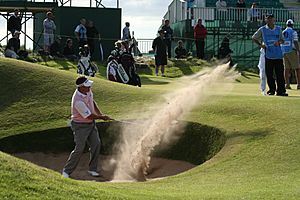
The "major championships" are the four most important men's golf tournaments each year. In order, they are:
- The Masters
- PGA Championship
- U.S. Open
- The Open Championship (also called the British Open)
The best golfers from all over the world play in these events. The Masters is always played at Augusta National Golf Club in Georgia, USA. It's the only major that stays at the same course every year. The U.S. Open and PGA Championship are played at different courses around the United States. The Open Championship is played at different courses around the United Kingdom.
Before the PGA Championship and The Masters started, the four majors used to be the U.S. Open, the U.S. Amateur, the Open Championship, and the British Amateur.
Biggest Women's Tournaments

Women's golf doesn't have one globally agreed-upon set of "majors." The LPGA Tour in the U.S. (the biggest women's tour) has five majors:
- Chevron Championship
- Women's PGA Championship
- U.S. Women's Open
- Women's British Open
- The Evian Championship
Only the Women's British Open and The Evian Championship are also seen as majors by the Ladies European Tour. However, the LPGA Tour is much more important in women's golf worldwide.
Biggest Senior Tournaments
Senior men's golf (for players aged fifty and over) also has "majors." The PGA Tour Champions in the U.S. recognizes five majors:
- Senior PGA Championship
- The Tradition
- Senior Players Championship
- United States Senior Open
- The Senior (British) Open Championship
The Senior PGA Championship is the oldest, started in 1937. The other events began in the 1980s when senior golf became very popular.
Golf at the Olympics
Golf was part of the Summer Olympic Games in 1900 and 1904. After a long break of 112 years, golf returned for the 2016 Rio Games. The International Golf Federation (IGF) is the main group for golf at the Olympics.
Women in Golf
It wasn't until 1552 that the first woman golfer, Mary Queen of Scots, played the game at St. Andrew's Links. But for a long time, women were not taken seriously in golf. Many men thought women weren't strong or skilled enough to play.
In 1891, the Shinnecock Hills in New York became the first club to allow women members. Four years later, in 1895, the U.S. Golf Association held the first Women's Amateur Championship.
In the 1920s, Joyce Wethered was a golf star, just like famous male golfer Bobby Jones. Jones even said she might have been the best golfer ever, male or female! But even his praise wasn't enough to change everyone's minds about women golfers.
In the late 1940s, the Royal Liverpool's club wouldn't let the wife of a famous golfer into their clubhouse. The club secretary even said, "No woman ever has entered the clubhouse and, praise God, no woman ever will." However, American golfer Babe Zaharias proved herself on the course. She became the first American woman to win the British Women's Amateur title in 1947. The next year, she tried to play in the U.S. Open, but the USGA said no, stating it was only for men.
The Ladies Professional Golf Association was started in 1950. It aimed to make women's golf more popular and give women more chances to compete. But the competitions were not the same for men and women. It wasn't until 1972 that the U.S. Congress passed Title IX of the Education Amendments. This law says: "No person in the United States shall, on the basis of sex, be excluded from participation in, be denied the benefits of, or be subject to discrimination under any education program or activities receiving Federal financial assistance." This helped create more equal opportunities in sports. American golfer Renee Powell moved to the UK in the 1970s and became the first woman to play in a British men's tournament in 1977.
Even as of 2016, women golfers were still working to have the same opportunities as men. There is still a big difference in prize money between the men's U.S. Open and the U.S. Women's Open.
International Golf Events
- Golf at the Asian Games
- Curtis Cup
- EurAsia Cup
- International Crown
- Golf at the Summer Olympics
- Golf at the Pan American Games
- Presidents Cup
- Ryder Cup
- Seve Trophy
- Solheim Cup
- Golf at the Summer Universiade
- Walker Cup
See also
 In Spanish: Golf para niños
In Spanish: Golf para niños



